

Aimee Swenson describes herself as a “geographer, artist and shepherdess. I climb mountains, fly in tiny airplanes, explore remote islands.” She is also a professional sheep shearer. She heads several organizations concerned with sheep and wool production. The Herdbeast is a global project, intended to foster connections among people involved in hand-grown wool. The project addresses the complex and necessary relationship between sheep and humankind.
Ms. Swenson travels the world to study wool harvesting in isolated communities for The Wool Away Project. She has visited Estonia four times, been to British Columbia, Sweden, Norway, the Faroe Islands and the Shetland Islands. She recently received two Masters degrees from Arizona State University, including an MFA in Intermedia and an MA in Interdisciplinary Studies with emphasis on geography, agricultural history and gender studies. Currently, she attends Michigan State University where she is pursuing her doctorate in Community Sustainability. Her research focuses on how politics affect indigenous people’s wool production, lifestyles, and human-animal relationships. In this interview, Swenson talked to SEE Magazine about her experience with the Navajo and their sacred Churro sheep. She also discussed the impact of the wool industry and marketing on small-scale wool production.
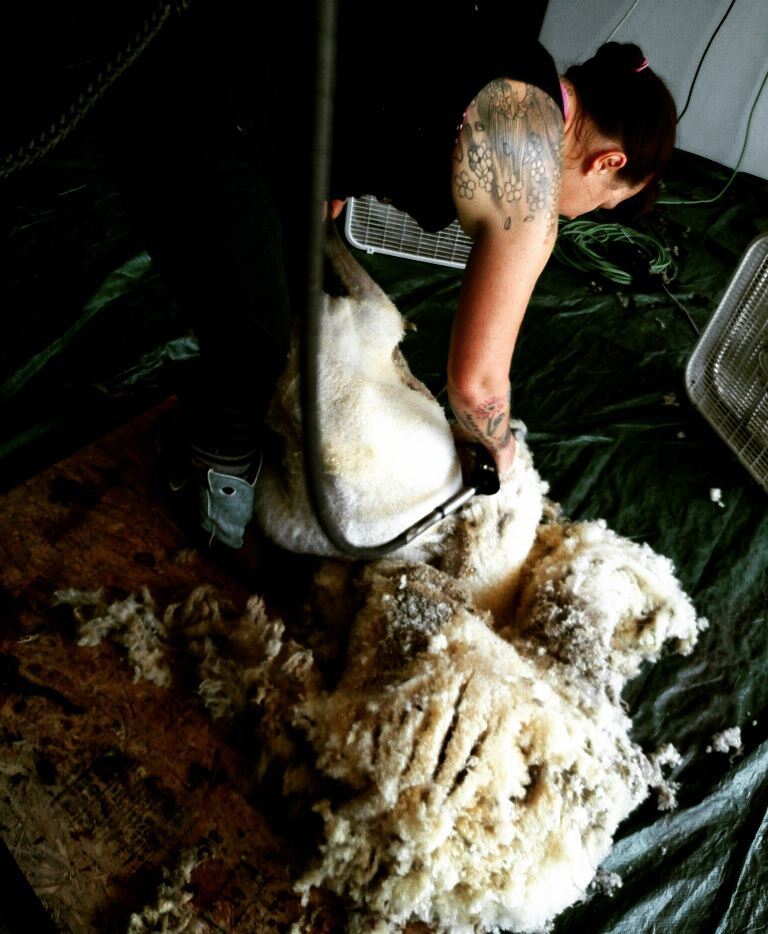
Aimee Shearing Sheep © Images Courtesy of Aimee Swenson
SEE: How would you describe your current studies?
AS: I am completing my PhD in Community Sustainability at Michigan State University. My dissertation work is specifically, but yet broadly, investigating the cultural value of livestock. I am work with what I regard as the historical ontologies of livestock within the cultural histories of war- provoked human migration. I cultivate pasture-raised organic pigs and chickens, and, as a facet of this, I work with animal behavior and human-animal relationships in the livestock husbandry systems.
SEE: How did you get started interacting with Navajo Churro sheep?
AS: I was going to farms to shear for people and noticed an insane amount of wool being piled up or thrown away. And, I would ask, ‘what do you want to do with your wool now that it’s off the sheep?’ and they said, ‘Just pitch it in the trash can.’ I just about had a meltdown. I started doing a little more research about that, and it morphed into: How does wool fit in to the current commodity cycles? Why are these people throwing wool away? What does that mean for cultural aspects? What does that mean for commodity aspects? How can we potentially get these small farms integrated back into the commodities cycle? Is that possible? My general consensus thus far, although there is always a possibility, is that our global economy is not conducive to supporting small farm wool production. There aren’t any little mills in the U.S., well worldwide actually, and we have a very high demand for merino wool. That’s very problematic for the other 200 plus breeds of sheep.There is a growing interest in wool products. You know, I’ve got to have my wool undershirt that looks very stylish from Patagonia that’s $95, made from merino wool and everybody thinks that’s great. But in all actuality, anyone who knows true quality wool and wool production cycles, knows it’s a crock.
The way the Navajo Churro sheep fit for me was, I was shearing them on one farm in northern Arizona. Churro need to be sheared twice a year since they are double coated sheep. These hadn’t been sheared in three years. It was like shearing battle armor off the animal. That wool had to be thrown away. It was added to a pile that was almost as tall as me from all the other previous years that they had been sheared. That really got me concerned because I knew a little bit about the history of the Churro as it fit into a U.S. history context, which is what I was really interested in: when sheep came in to the U.S. and how that helped formulate our contemporary existence, how sheep are used as a colonization tool, and how they have helped to formulate the development of U.S. towns, roads - our overall infrastructure and actual existence.
The Churro sheep, of course, have a very rich history. The original version of the Churro was brought from southern Mexico up to Arizona and New Mexico. But it wasn’t necessarily called a Navajo Churro sheep then. It’s a derivative from a Spanish breed and, very early on, sheep were used as a commodity for trading in land disputes and for all sorts of things. Also very early on, they were bred in with the merino. We’re talking like in the 1500’s here. Now, what we consider the historical presence of the Navajo Churro sheep entered the indigenous cycle in about the 1600’s when they took on the form that they have now. A lot of that had to do with land bartering and, at that point, Navajo history also changes. The Navajo consider the sheep a re-birth of their culture. From that point forward, the sheep become their cultural identifier and determine how they function with the land, as well as with other indigenous tribes and colonizers. Over time, the sheep took over who they were.
Then, in the 1800’s we have the Long Walk, where all of the Navajo and Hopi were rounded up and walked into New Mexico. All of their sheep were confiscated, they were interred for 4 to 5 years, and when they were released, as reparation, the government gave each Navajo 1.5 sheep—man, woman, or child. But when they confiscated the Churro sheep from the Navajo, they exterminated many of them. As we see colonizers go into certain areas of the world, we also see their sheep breeds change because white wool is more valuable than brown for trading – and we can all argue that. But indigenous sheep are often classified very much like indigenous cultures and that’s exactly what happened with the Navajos.
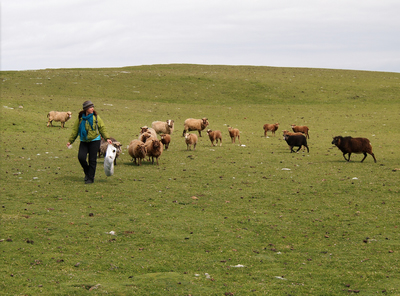
Aimee Collecting Hentilagets, Shetland Islands © Images Courtesy of Aimee Swenson
SEE: So they actually started eliminating the sheep in the late 1800’s…
AS: Yes. That was the main event that is recorded in our history. That was the result of the Long Walk. Once they [the Native Populations] were released, they were put on reservations. At that point, there were efforts by the Navajo to breed out the merino because they were given all of these half-breed weird sheep and they wanted their original sheep back. They were able to do that very satisfactorily over quite some time. In the early 1900’s, they had become such a sheep culture that the U.S. government said, ‘Your sheep have over-run the Southwest and you have exterminated all of the wild life, you’ve sucked our soil dry and we need to build a dam and therefore, your sheep are going.’ So there was a huge livestock roundup. The government literally would go to the hogans and slaughter the sheep on sight or they would round them up and run them off of cliffs. That happened in the late 1920’s and early ‘30’s. There was over a million Churro sheep at that point.There are pros and cons to both sides of all of these stories. While I empathize with the Navajo primarily, I do understand some of the ecological implications that happen with over-grazing of sheep. I try to take all of that into context.
SEE: Do you think there really was over-grazing?
AS: Yes, I do. But, I also feel that the way that the government handled it was completely ignorant of the cultural implications. Again, the Navajo identifies through their animal. They are treated with high value just as a person would be. They recognize that the sheep have a place, both in the family and in the greater culture. So, if you’re sending US military officials to hogans in a village and shooting them on sight in front of their owners, that’s going to have a massive cultural backlash. It’s going to affect them in ways that are still affecting them today. When the government went in and did this mass extermination, they literally exterminated like 1.5 million sheep. And what happened was, the Navajo took a few hundred of them before they were caught and hid them up in the hills. Those few remaining sheep were managed and bred by the Navajos up until the 1970s.
At that point, Dr. Lyle McNeal becomes a key player in this whole shenanigan. He’s at Utah State where he is head of the sheep program. But he’s also the head of all the sheep production up there. Anyway, in the 1970’s, he and a team of his grad students were working in California. [Dr. McNeal taught at California Polytechnic State University at San Luis Obispo at that time]. They came across a sheep on somebody’s farm and he didn’t know what it was, so they started doing research. Come to find out it was a Navajo Churro sheep. At that point, he found out all that had happened and he and his grad students initiated the “Navajo Churro Sheep Project.” He is the key player in insuring that breeding has proliferated up until now. He put all of the parameters in place and assisted in getting governmental protection for them. The status we’re at now is about 5,000-ish of them.
SEE: 5,000? That’s still not many.
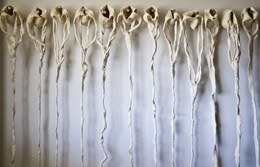
Detail of Aimee's Artwork © Images Courtesy of Aimee Swenson
AS: It’s not many. And I say, “ish,” because of the parameters for the protection of these sheep. There is a Navajo Churro inspector. He is the person who goes around and inspects all registered Navajo Churro sheep. If you have a flock and you have offspring from registered Navajo Churro sheep, and you want to keep them registered, then you need to have them inspected by him.
SEE: Is it a good thing that they’re registered? For protection?
AS: Oh, yes. So, the other caveat to that is, not all Churro sheep are registered. The ones that are kept on reservations are not. We, the general public, have no rights to that knowledge. Only the Navajos have those numbers and only they have that knowledge. So, it’s a protective measure for them. However, this is where it gets kind of dicey. I’m not sure you know what’s going on up there. They are having livestock seizures going on right now.
SEE: Oh, no. On the reservation right now? Why?
AS: Yes. What’s happening is that coal slurry extraction is going on underneath the reservation. Theoretically, when we think of coal drilling, we think of going straight down. But, what happens with coal slurry, is that they come way out, outside of the boundary, run the pipe down under the ground to get to a pocket. To do that, they need to have rights to the land on top of that. So, what’s happening is very, very contentious because the Hopi are the tribal police and BLM works with the Hopi to do the livestock seizures. And, the reason that they’re doing the livestock seizures is because, and you will not find this in blatant text, but the reason that they’re doing livestock seizures is that if you take that animal from that person, then that person no longer needs that land. As a result, that person no longer has a cultural tie to that land through the animal. They may have a tie to the land, but they won’t have any use for it, theoretically. That’s the rationale. So, what I look at is how the government uses livestock seizures to uproot cultures. And specifically, the main case is the Navajo Churros. But we also, right now, are having the exact same issue with the Apache and their horses. That’s happening in Oklahoma and Nebraska.
SEE: It’s so the government can get to what’s under their land?
AS: Yes. So, this is an epidemic, really. It does not get talked about in the media for obvious reasons. The U.S. government basically owns these mineral extraction companies. In fact, Dick Cheney was chairman of the board of the company that is doing the coal slurry underneath the Navajo reservation. He was chairman of the board for like 20 years.
SEE: So you’re saying that the Navajo don’t own the land because it’s reservation.
AS: Yes, they just have rights to the land.
SEE: The government can go in and take that land if they want to?
AS: They’re justifying it. They’re basically saying that the mineral extraction is more important than the cultural placement of these people. Even though we are not supposed to be allowed to touch that reservation land at all. So, that’s that. Now that I’m no longer in Arizona, I look at how political movements or political changes affect livestock heritage on a global level. For instance, I mentioned that I’m going to Estonia soon. There’s a breed of sheep that lives on an island there. There are only 30 left in the world. They are a product of this Swedish and Estonian ethnicity, because they were left behind prior to the second Soviet occupation when Sweden required all the Swedes to leave Estonia. That sheep is now genetically altered, it is completely inbred, and they’re trying to figure out if they can reverse it. I’m dealing with how our political movements affect these breeds that are culturally important, that act as cultural identifiers, and how that changes over time based on what we do politically.
SEE: That’s a lot to take on but it’s very important. I’m seeing connections between what populations like the Navajo need for their survival and their traditions and what the general public wants. Like the Merino wool issue— I’m sure I’ve bought woolen items at REI and it’s probably Merino wool. This may be a great product but how does that affect other people? How do our actions or the actions of the government and the needs of the Navajo reservation… how does that all co-mingle? What can we do to help preserve traditions, too? So, the question I always come to is how can I help?’ Because ‘helping’ isn’t always simple.
AS: Exactly, especially in these cases. I also don’t have an answer to that—and actually one of the parameters of my dissertation research is, what are the ethical implications of embedding ourselves in this kind of work? For me personally, I look at these breeds of sheep and all I want to do is save them. But, what are the ethical implications of that? Of me stepping in as a non-cultural member saying, ‘okay, I want to fix this for you.’ If we back up and maybe remove ourselves from that… I think awareness is, first and foremost, one of the best things that we can do. Because, when I do talks about sheep and wool, I’d say 90% of my listeners -- even if they know about spinning and weaving and are fascinated by sheep -- have no idea what goes on behind the scenes. None whatsoever. They have no idea of the history, the culture, and all of these things that are tied to using wool and getting involved with these breeds of sheep. So, I think awareness is the first step.
The main thing that we can do is put the information and stories out there into the vernacular, into history, because, clearly, there is no media attention on most of this. Beyond that, I think creating an understanding of true wool use, quality wool, but… You know, it’s like asking whether Gatorade or Powerade is the better drink.The basis for my research overseas started from this Churro issue. I thought, okay, America can’t be the only place where this is happening. I go to these very insular places that are very sheep dependent. The wool culture has to be different than it is here. I went to the Faroe Islands for several weeks where they don’t even have a mill left. The entire country shears sheep. Everybody comes together to bring these sheep out of the mountains. Sheep outnumber humans four to one there. They throw all of the wool in the ocean or burn it and it is as high quality as Navajo Churro sheep’s wool. The structure of the wool is almost exactly the same. It’s crazy.
Now, when you look at the Shetland Islands, that’s a little different. We always hear about ‘Shetland wool’ and that’s very trendy right now, so there’s a different type of thing going on there. But the wool market is so bad worldwide, that the likelihood that this is going to change for other small farms and special breeds is very, very small. There are so many Merino sheep in the world that it is quantity over quality. Merino wool, if you ask me, is crap. It is very soft and fine, which is what we like. We, as human beings, are all about comfort nowadays. We don’t want something that might be more utilitarian. So, the likelihood that we’re going to wear anything that is coming off of a Churro sheep is very small. The history behind their wool, actually, comes more in the form of rugs, including the whole lineage of Navajo rugs, which were a product of colonialist trading. The colonizers needed a product that they could get from the indigenous tribes and that turned out to be rugs. They could produce rugs in large quantities, fairly quickly, for trading purposes. The rugs are only part of their culture because we identify them as part of their culture. But that is a result of trading posts.
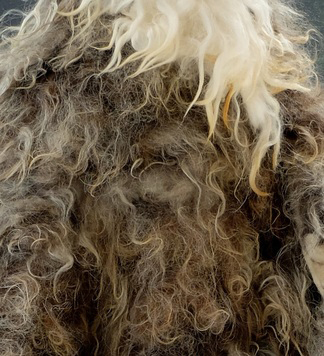
Close-up of Sheep's Wool © Images Courtesy of Aimee Swenson
SEE: If the Navajo are not using the wool are they using the meat?
AS: Yes.
SEE: For themselves or to sell?
AS: Mostly for themselves. They are selling to some restaurants like the Fry Bread House in Phoenix and places up north. When you order lamb there it probably comes from the reservation.
SEE: Do the Navajo have an interest in the wool?
AS: Their interest is decreasing because the younger generations are more interested in trying to get off the reservation than trying to save the culture. The poverty rate is extremely high on the reservation.
SEE: I think we have our feelings about the politics of the situation but we also recognize that it’s complicated.
AS: Black Mesa Indigenous Support Group is an activist group for that area, primarily the Navajo, but I do believe they do some work with the Hopi.
SEE: Is it accurate to say that recent tensions can be traced back to the 1974 Navajo-Hopi Land Settlement Act and the Navajo-Hopi land dispute?
http://www.multinationalmonitor.org/hyper/issues/1986/06/parlow.html
http://www.azcentral.com/story/news/arizona/politics/2015/02/09/lawmakers-seek-to-wrap-up-costly-tribal-relocation-program/23122259/
AS: Yeah, but that actually started in the ‘40s with a mineral extraction deal that happened. A lawyer affiliated himself with the Hopis instead of the Navajos. He basically bought them out to get the mineral extraction rights under the land. It caused a division between the Navajos and the Hopis. They were fine before then. It all started over mineral extraction. The Hopi Rangers are the ones who are affiliated with BLM (Bureau of Land Management), and the ones who are going in and taking the animals on the disputed lands. That’s why there have been conflicts with them because in the ‘80s they were the same ones.
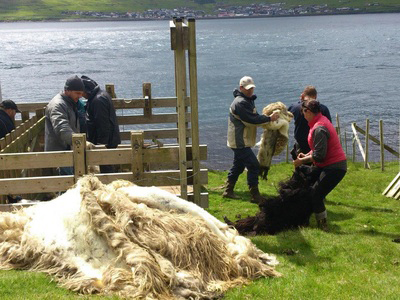
Aimee's Future of Fleece Program © Images Courtesy of Aimee Swenson
SEE: And as you said before -- livestock seizures are taking place now….
AS: They’re rounding them up but they’re not admitting that it is for mineral extraction. They’re using the pretext that these people need to pay taxes on these animals and if they haven’t paid taxes on them, then they’re being seized. If you go back into the history… It’s all so convoluted at this point in time that no one can see through any of it. But if you go back through the history, Navajos were not required to pay taxes on their animals! But now the U.S. government is saying that they are required to pay taxes on the animals and using that as the basis for seizing the animals. They’re shipping the sheep to New Mexico and then they come back and say, ‘Oh well, if you want your animals back, you’ve got to pay the taxes, and you gotta go pick them up!’
These people are living in poverty. Even if they had to pay taxes on their animals, they wouldn’t be able to do it! So they’re being charged something like five times what the animal is even worth to get them back. Who it’s really affecting is the elderly, because the elderly are the ones who are still tied to sheepherding. Very few young people do sheepherding nowadays, so you have these 70-year- old women—the matriarchs are the ones who do the sheepherding in the Navajo culture—sitting there helpless while the Hopi are there taking their sheep! Therefore, these women have no livelihood left. They made a little bit of money by selling the meat or selling the wool at the trading post, or something like that. They are left with no income, no tie to the land, and nowhere else to go! At that point, they often end up going off reservation to stay with young relatives. Since they’re no longer on the reservation, there you go! The land is clear!!
SEE: That’s horrible!
AS: It is absolutely horrible. Black Mesa Indigenous Support has a website and they have lots of postings. The images that you see there are usually of the elderly. They actually have some interviews there, too. It’s the young people translating for the elderly who are being affected by this. It’s usually the granddaughter who’s translating for the grandmother whose sheep were just taken. One woman, she had 80 sheep taken, and they want her to pay something like fifteen hundred dollars to get them back. They’re sitting in New Mexico and she has no way to get them. They don’t even have a trailer!! It’s an angering situation, and for me, I wanted to go right up there!You will see, the more you look into this, that some people have posted online, that in their opinion, this is cultural genocide. I agree with that. It really is a low-handed way to exterminate Navajo culture.
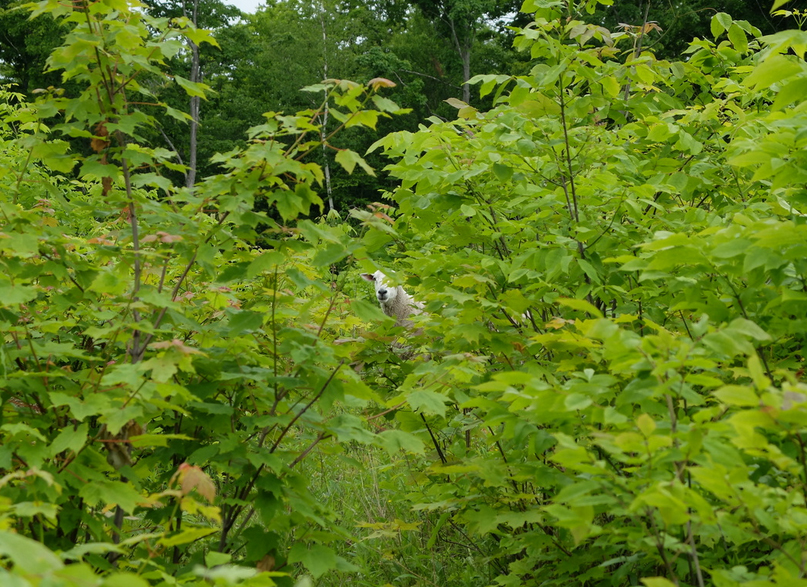
"Greeting the Sheep"; Durational at Galusha Hills Farm, Vermont © Images Courtesy of Aimee Swenson
SEE: It’s indirect and corrupt.
AS: And it’s through the animal. It’s all through taking that sheep.
SEE: Any sheep? Not just Churro?
AS: Any sheep they have.
SEE: Unbelievable.
AS: So that’s the key. The goal is to culturally exterminate this group of people, to culturally remove this group of people, by going through their animal, because their animal is their cultural identifier. It is the tie to the land. It is their tie to their income and their well being. It is their food source—everything. You take that animal away from them and you basically take their life away from them.
SEE: That’s why the animal is so important! You start with the animal because that’s everything.
AS: It is. It’s the animal. That’s why from here on out, that’s what all of my work is about. It’s about how people use the animal as an access point to culture and how we can shape culture through accessing one animal breed.
SEE: I think that’s the heart of this whole issue.
AS: Yes.